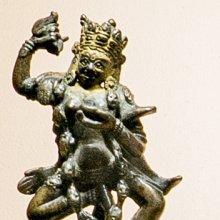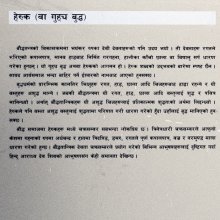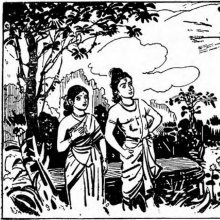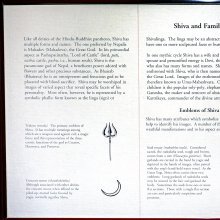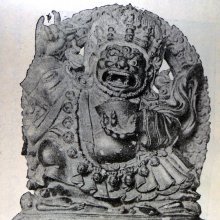Blood: 3 definitions
Introduction:
Blood means something in Hinduism, Sanskrit. If you want to know the exact meaning, history, etymology or English translation of this term then check out the descriptions on this page. Add your comment or reference to a book if you want to contribute to this summary article.
Images (photo gallery)
(+5 more images available)
In Hinduism
Yoga (school of philosophy)
Source: ORA: Amanaska (king of all yogas): A Critical Edition and Annotated Translation by Jason Birch(That which is) Blood is denoted by the Sanskrit term Lohita (as opposed to Alohita—‘bloodless’), according to the Bṛhadāraṇyikopaniṣat 3.8.6.—Accordingly, while describing the absolute nature of Brahma: “Gārgi said, ‘Yājñavalkya, that which is above the sky, below the earth, between the two and called [past, present and future], is stitched and cross-stitched in what?’ Yājñavalkya said, ‘Gārgi, the Brahmins call that very [thing] the imperishable one. [e.g., It is bloodless (ālohita) [...]’”.

Yoga is originally considered a branch of Hindu philosophy (astika), but both ancient and modern Yoga combine the physical, mental and spiritual. Yoga teaches various physical techniques also known as āsanas (postures), used for various purposes (eg., meditation, contemplation, relaxation).
Ayurveda (science of life)
Source: ORA: Amanaska (king of all yogas): (ayurveda)Blood is denoted by the Sanskrit term Rakta, according to the Kāśyapasaṃhitā (Khilasthāna, verse 9.43-45ab) in a chapter on abdominal swelling caused by vitiation of the blood (raktagulma).—Accordingly, “Listen to the cause of that which produces the cravings [of a seemingly pregnant woman with raktagulma]. Generally, there is desire for those tastes which cause an increase of the bodily constituents because of the true similarity of their origin. [When] the vitiated blood (rakta) has a Vāta or Pitta [imbalance] and is accumulating, it fuels desire for tastes such as [those which are] acrid, sour, salty and so on”.

Āyurveda (आयुर्वेद, ayurveda) is a branch of Indian science dealing with medicine, herbalism, taxology, anatomy, surgery, alchemy and related topics. Traditional practice of Āyurveda in ancient India dates back to at least the first millenium BC. Literature is commonly written in Sanskrit using various poetic metres.
Shaktism (Shakta philosophy)
Source: Google Books: ManthanabhairavatantramThe Blood is sometimes associated with Ṣaṣṭhānanda—one of the Sixteen Siddhas according to the Manthānabhairavatantra, a vast sprawling work that belongs to a corpus of Tantric texts concerned with the worship of the goddess Kubjikā.—These sixteen spiritual teachers represent the disciples of the Nine Nāthas who propagated the Western Transmission noted in the Kubjikā Tantras.—Various texts record the locations of the sixteen Siddhas within the body (called ‘doors’). For example, the Kulakaulinīmata mentions the Navel, whereas the Ṭīkā mentions the Forehead (bindusthāna) and the Kumārikākhaṇḍa mentions Blood as the location of Ṣaṣṭhānanda.

Shakta (शाक्त, śākta) or Shaktism (śāktism) represents a tradition of Hinduism where the Goddess (Devi) is revered and worshipped. Shakta literature includes a range of scriptures, including various Agamas and Tantras, although its roots may be traced back to the Vedas.
See also (Relevant definitions)
Starts with (+7): Blood flower, Blood flowers, Blood hilder, Blood letting, Blood lily, Blood orange, Blood plant, Blood plum, Blood red tassel flower, Blood seed, Blood-flowered milkweed, Blood-letting, Blood-twig, Blood-twig dogwood, Bloodberry, Bloodflower, Bloodleaf, Bloodless, Bloodroot, Bloodtwig dogwood.
Query error!
Full-text (+2581): Rudhira, Shonita, Rakta, Lohita, Kshataja, Kilala, Asrij, Asra, Raktapitta, Asrikpata, Raktaprameha, Raktashaya, Rasya, Saptadhatu, Raktavikara, Raktapata, Rohita, Raktapinda, Puyashonita, Raktavarna.
Relevant text
Search found 447 books and stories containing Blood; (plurals include: Bloods). You can also click to the full overview containing English textual excerpts. Below are direct links for the most relevant articles:
Work of Art < [July – September, 2000]
“On the eve of Independence” < [October – December, 1998]
Separation < [January – March, 1979]
Mahabhagavata Purana (translation and study) (by Prabir Kumar Nanda Goswami)
Chapter 17 - Brahmayoga advice
Chapter 23 - The Thousand names of Lalita (Sahasranama)
World Journal of Pharmaceutical Research
Erectile dysfuction” mechanism, causes and treatment < [2022: Volume 11, Septmber issue 12]
Case report on HTLV-1 induced acute T-cell leukemia/lymphoma. < [2021: Volume 10, July special issue 9]
Effect of Anogeissus leiocarpus on broiler blood electrolytes/bio. < [2020: Volume 9, December issue 15]
Mahabharata (English) (by Kisari Mohan Ganguli)
International Ayurvedic Medical Journal
Ayurvedic management of infected diabetic wound — a case report < [2021, Issue 2, February]
Tobacco products: chemical analysis and comparative harmfulness < [2021, Issue 4, April]
A concept of rakta dhatu w.s.r to kriyasharir-review artical < [2014, Issue III May-June]
Svacchandatantra (history and structure) (by William James Arraj)
Svacchandatantra, chapter 15 (Summary) < [Summaries]
Translation of Chapter 13, verses 1-46a < [Translation excerpts]
Svacchandatantra, chapter 13 (Summary) < [Summaries]
Related products
(+78 more products available)
